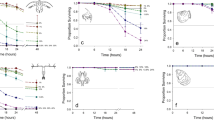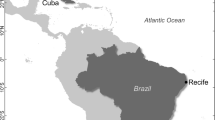Abstract
Dense populations of the coccolithophore Pleurochrysis pseudoroscoffensis were found in surface films at several locations around the Salton Sea in February–August, 1999. An unidentified coccolithophorid was also found in low densities in earlier studies of the lake (1955–1956). To our knowledge, this is the first record of this widespread marine species in any lake. Samples taken from surface films typically contained high densities of one or two other phytoplankton species as well as high densities of the coccolithophore. Presence or absence of specific algal pigments was used to validate direct cell counts. In a preliminary screen using a brine shrimp lethality assay, samples showed moderate activity. Extracts were then submitted to a mouse bioassay, and no toxic activity was observed. These results indicate that blooms of P. pseudoroscoffensis are probably not toxic to vertebrates and do not contribute to the various mortality events of birds and fish that occur in the Salton Sea.
Similar content being viewed by others
References
Bain, R. C., A. M. Caldwell, R. H. Clawson, H. L. Scotten & R. G. Willis, 1970. Salton Sea California: water quality and ecological management considerations. U.S. Dept. Interior, Fed. Wat. Qual. Administration, Pacific Southwest Region: 54 pp.
Barlow, S. B. & P. Kugrens, 2002. Cryptomonads from the Salton Sea, California. Hydrobiologia/Dev. Hydrobiol. (in press).
Berge, G., 1962. Discoloration of the sea due to Coccolithus huxleyi ‘bloom’. Sarsia 6: 27–40.
Billard, C., 1994. Life cycles. In Green, J. C. & B. S. C. Leadbeater (eds), The Haptophyte Algae, Systematics Association special volume no. 51. Clarendon Press, Oxford: 167–186.
Blackburn, S. I. & G. Cresswell, 1993. A coccolithophorid bloom in Jervis Bay, Australia. Aust. J. mar. freshwat. Res. 44: 253–260.
Carpelan, L. H., 1961. Phytoplankton. In Walker, B. W. (ed.), The Ecology of the Salton Sea, California in Relation to the Sportfishery. Calif. Dept. Fish. Game, Fish Bull. 113: 33–42.
Cohen, M. J., J. I. Morrison & E. P. Glenn, 1999. Haven or Hazard: the Ecology and Future of the Salton Sea. Pacific Institute, Oakland, California: 64 pp.
Dahl, E., O. Lindahl, E. Paasche & J. Throndsen, 1989. The Chrysochromulina polylepis bloom in Scandinavian waters during spring 1988. In Cosper, E. M., V. M. Bricelj & E. J. Carpenter (eds), Coastal and Estuarine Studies, vol 35, Novel Phytoplankton Blooms. Springer-Verlag, Berlin: 383–405.
Eikrem, W. & J. Throndsen, 1993. Toxic prymnesiophytes identified from Norwegian coastal waters. In Smayda, T. J. & Y. Shimizu (eds), Toxic Phytoplankton Blooms in the Sea. Elsevier, Amsterdam: 687–692.
Fresnel, J. & C. Billard, 1991. Pleurochrysis placolithoides sp. nov. (Prymnesiophyceae), a new marine coccolithophorid with remarks on the status of cricolith-bearing species. Br. Phycol. J. 26: 67–80.
Gayral, P. & J. Fresnel, 1983. Description, sexualité et cycle de développment d'une nouvelle coccolithophoracée (Prymnesiophyceae): Pleurochrysis pseudoroscoffensis sp. nov. Protistologica 19: 245–261.
Green, J. C., K. Perch-Nielsen & P. Westbroek, 1990. Phylum Prymnesiophyta. In Margulis, L., J. O. Corliss, M. Melkonian & D. J. Chapman (eds), Handbook of Protoctista. Jones & Bartlett Publishers, Boston: 293–317.
Groom, S. B. & P. M. Holligan, 1987. Remote sensing of coccolithophore blooms. Adv. Space Res. 7: 73–78.
Hallegraeff, G. M. & Y. Hara, 1995. Taxonomy of harmful marine raphidophytes. In Hallegraeff, G. M., D. M. Anderson & A. D. Cembella (eds), Manual on Harmful Microalgae. IOC Manuals and Guides no. 33. UNESCO Publishing, Paris: 365–371.
Hansen, L. R., J. Kristiansen & J. V. Rasmussen, 1994. Potential toxicity of the freshwater Chrysochromulina species C. parva (Prymnesiophyceae). Hydrobiologia 287: 157.
Hasle, G. R., 1978. Settling: the inverted-microscope method. In Sournia, A. (ed.), Phytoplankton Manual. UNESCO Publishing, Paris: 88–96.
Heimdal, B. R., 1993. Modern coccolithophorids. In Tomas, C. R. (ed.), Marine Phytoplankton, a Guide to Naked Flagellates and Coccolithophorids. Academic Press, Inc., San Diego, California: 147–247.
Holligan, P. M., M. Viollier, D. S. Harbour, P. Camus & M. Champagne-Philippe, 1983. Satellite and ship studies of coccolithophore production along a continental shelf edge. Nature 304: 339–342.
Honjo, S., 1982. Seasonality and interaction of biogenic and lithogenic particulate flux at the Panama Basin. Science 218: 883–884.
Hurlbert, S. H. & M. S. Mulla, 1981. Impacts of mosquitofish (Gambusia affinis) predation on plankton communities. Hydrobiologia 83: 125–151.
Iverson, R. L., F. L. Nearhoof & M. O. Andreae, 1989. Production of dimethylsulfonium propionate and dimethylsulfide by phytoplankton in estuarine and coastal waters. Limnol. Oceanogr. 34: 53–67.
Jeffrey, S. W. & M. Vesk, 1997. Introduction to marine phytoplankton and their pigment signatures. In Jeffrey, S. W., R. F. C. Mantoura & S. W. Wright (eds), Phytoplankton Pigments in Oceanography: Guidelines to Modern Methods. UNESCO Publishing, Paris: 37–84.
Jeffrey, S.W. & S.W. Wright, 1994. Photosynthetic pigments in the Haptophyta. In Green, J. C. & B. S. C. Leadbeater (eds), The Haptophyte Algae, Systematics Association special volume no. 51. Clarendon Press, Oxford: 111–132.
Jehl, J. R. Jr., 1996. Mass mortality events of eared grebes in North America. J. Field Ornith. 67: 471–476.
Johansen, J. R., G. J. Doucette, W. R. Barclay & J. D. Bull, 1988. The morphology and ecology of Pleurochrysis carterae var. dentata var. nov. (Prymnesiophyceae), a new coccolithophorid from an inland saline pond in New Mexico, U.S.A. Phycologia 27: 78–88.
Lund, J.W. G., C. Kilpling & E. D. LeCren, 1958. The inverted microscope method of estimating algal numbers, and the statistical basis of estimation by counting. Hydrobiologia 11: 143–170.
Meyer, B. N., N. R. Ferrigni, J. E. Putman, L. B. Jacobsen, D. E. Nichols & J. L. MacLaughlin, 1982. Brine shrimp: a convenient general bioassay for active plant constituents. Pl. Med. 45: 31–34.
Milliman, J. D., 1980. Coccolithophorid production and sedimentation, Rockall Bank. Deep Sea Res. 27: 959–963.
Moestrup, Ø., 1994. Economic aspects: ‘blooms’, nuisance species, and toxins. In Green, J. C. & B. S. C. Leadbeater (eds), The Haptophyte Algae, Systematics Association special volume no. 51. Clarendon Press, Oxford: 265–285.
Moestrup, Ø. & H. A. Thomsen, 1995. Taxonomy of toxic haptophytes (Prymnesiophytes). In Hallegraeff, G. M., D. M. Anderson & A. D. Cembella (eds), Manual on Harmful Microalgae. IOC Manuals & Guides No. 33, UNESCO Publishing: 319–338.
Reich, K. & M. Aschner, 1947. Mass development and control of the phytoflagellate Prymnesium parvum in fish ponds in Palestine. Palestine J. Bot. Jerusalem 4: 14–23.
Reifel, K. M., M. P. McCoy, T. E. Rocke, M. A. Tiffany, D. J. Faulkner & S. H. Hurlbert, 2002. Possible importance of algal toxins in the Salton Sea, California. Hydrobiologia/Dev. Hydrobiol. (in press).
Reynolds, C. S., 1984. The Ecology of Freshwater Phytoplankton. University Press, Cambridge: 384 pp.
Saar, R. A., 2000. The unbearable capriciousness of Bering. Science 287: 1388–1389.
Shilo, M. & M. Shilo, 1955. Control of the phytoflagellate Prymnesium parvum. Verh. int. Ver. Limnol. 12: 233–240.
Sieburth, J. M., 1979. Sea Microbes. Oxford University Press, New York: 491 pp.
Solis, P. N., C. W. Wright, M. M. Anderson, M. P. Gupta & J. D. Phillipson, 1993. A microwell cytotoxicity assay using Artemia salina (brine shrimp). Pl. Med. 59: 250–252.
Throndsen, J., 1978. Preservation and storage. In Sournia, A. (ed.), Phytoplankton Manual. UNESCO Publishing, Paris: 69–74.
Tiffany, M. A., S. B. Barlow, V. E. Matey & S. H. Hurlbert, 2001. Chattonella marina (Raphidophyceae), a potentially toxic alga in the Salton Sea, California. Hydrobiologia 466 (Dev. Hydrobiol. 162): 187–194.
Turner, S. M., G. Malin, P. S. Liss, D. S. Harbour & P. M. Holligan, 1988. The seasonal variation of dimethylsulfide and dimethylsulfoniopropionate concentrations in near-shore waters. Limnol. Oceanogr. 33: 364–375.
Vairavamurthy, A., M. O. Andreae & R. L. Iverson, 1985. Biosynthesis of dimethylsulfide and dimethylpropiothetin by Hymenomanas carterae in relation to sulfur source and salinity variations. Limnol. Oceanogr. 30: 59–70.
Walker, B. W., 1961. The ecology of the Salton Sea, California in relation to the sportfishery. Calif. Dept. Fish. Game, Fish Bull. 113: 1–204.
Watts, J. M., B. K. Swan, M. A. Tiffany & S. H. Hurlbert, 2001. Thermal, mixing and oxygen regimes of the Salton Sea, California, 1997-1999. Hydrobiologia 466 (Dev. Hydrobiol. 162): 159–176.
Wright, S. W., S. W. Jeffrey, R. F. C. Mantoura, C. A. Llewellyn, T. Bjornland, D. Repeta & N. Welslehmayer, 1991. An improved HPLC method for the analysis of chlorophylls and carotenoids from marine phytoplankton. Mar. Ecol. Prog. Ser. 77: 183–196.
Author information
Authors and Affiliations
Rights and permissions
About this article
Cite this article
Reifel, K.M., McCoy, M.P., Tiffany, M.A. et al. Pleurochrysis pseudoroscoffensis (Prymnesiophyceae) blooms on the surface of the Salton Sea, California. Hydrobiologia 466, 177–185 (2001). https://doi.org/10.1023/A:1014551804059
Issue Date:
DOI: https://doi.org/10.1023/A:1014551804059




